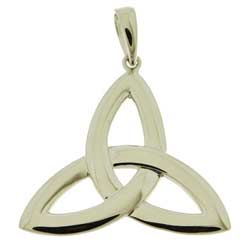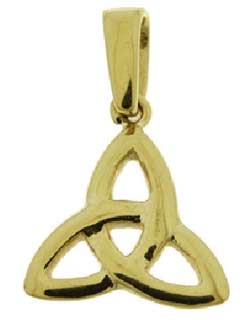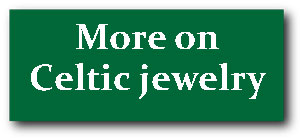The trinity knot, or triquetra as it is also known, is one of the most widely used designs in Celtic jewelry.
It is often the main motif in necklaces, pendants and ear-rings etc, but can also be incorporated into more complex pieces with other popular Irish designs such as Claddagh rings and Celtic crosses. This versatility means that most jewelry stores will have at least a few items which feature it in some way or another.
The trinity knot had deep symbolic meaning for the ancient Celts and was later adopted as a significant, religious icon by the early Christians in Ireland and mainland Europe.

The symbolism stems from the way the trinity knot weaves three interlocking sections from one continuous line. The Celts believed that most of life’s important elements occurred in threes. For example:
- youth, adulthood and old age
- earth, sea and sky
- past, present , future
The interwoven shapes were considered to represent these groups of three.
Spiritual symbolism of the trinity knot
However, the symbolism went further than that for the three shapes were made up on one continuous line that had no beginning and no end. This was held to represent the spiritual life, which also had no beginning or end.
The potential for rich symbolism with the trinity knot also appealed to the early missionaries who converted the Irish to Christianity. In the same way that St Patrick was said to have adopted the Celtic cross as a Christian emblem, so other early Christians adopted the trinity knot.

They saw the three interlocking shapes as symbolising the holy trinity of the Father, the Son and Holy Spirit. St Patrick is said to have used to the shamrock in the same way.
The one continuous line with no beginning or end symbolised the eternal nature of God. These concepts would have been familiar to the Celts, perhaps making it easier for them to accept the new Christian religion.
Fish shape designs signifying Christianity
The knot also had an extra significance for Christians because it resembled the three interlocking fish shapes which were used to represent Christianity from the very early days in Rome, long before the cross was adopted as a symbol. Fish shape designs signifying Christianity and dating back nearly 2,000 years can still be seen on the ancient catacombs in Rome today.
The trinity knot first came to prominence in Celtic art produced by Irish monks more than a thousand years ago. Its newfound Christian significance meant it was an appropriate design for illustrating religious manuscripts.
It can be found on early transcripts of the Bible, most notably in the Book of Kells which is now on display in Trinity College, Dublin.

Trinity knot in Celtic jewelry
There is a common variation on the theme in which the trinity knot is set against a circle which intersects the three loops. This adds complexity to the design and perhaps makes it even more intriguing. The circle is thought to highlight the unity of the three loops. It is also seen by Christians as representing the eternal nature of God.
The use of the trinity knot in Celtic jewelry didn’t become widespread until the second half of the 19th century when a nationalist feeling was sweeping Ireland and people wanted to reconnect with their heritage.
It is now popular across the world. It is often given by a man to his wife or girlfriend as a token of his love. The three interlocking shapes then come to symbolise three vital elements of a relationship such as love, honour and respect, or perhaps love, honour and protect.
As well as the beautiful symmetry of the design itself, many people turn to it because it may have an emotional, symbolic meaning to them.
This could relate to Christianity, or it could be the Celtic connection that appeals with people using it as a way of claiming and acknowledging their Irish heritage.
Triquetra or Trinity Knot – ancient Celtic Symbol

See the Triquetra design on numerous gifts in Bealtaine Fire